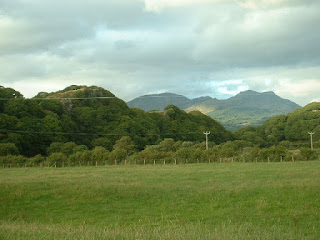 |
| North York moors, Yorkshire, England. |
Remnants of the Wildwood
Britain’s vast areas of wild and wuthering moorland and heath certainly have their appeal, and some of the land, such as the North York Moors, has been designated as National Parks. While many upland areas are devoid of all but heathland shrubs and grasses, thankfully there are still many fertile valleys and man-made plantations managed by the Forestry Commission.
However, if we look further back in history, we can see that what we are now left with are – by comparison – a few grotesquely-stunted remnants of a great and diverse, natural “wildwood” that covered much of Britain.
The first trees began to colonize Britain in the late glacial period following the Ice Age, around 10,000 BC. At the beginning of the Neolithic Age (New Stone Age) which began 6,500 years ago, natural woodland in Britain covered everywhere that trees could grow, limited only by waterlogging, high altitudes, and severe wind exposure.
Deforestation – and the associated degradation of the wider natural environment – began in the Neolithic Age, between 4500 and 2000 BC. This process was continued in the Bronze Age, between 2000 and 600 BC. The Bronze Age settlers would cultivate and exhaust areas of land and then move on, leaving the land so infertile and increasingly acidic that it was incapable of supporting anything other than heathland vegetation such as heather, gorse and coarse grasses. Then the Iron Age Celts who arrived on our shores around 400 BC completed the task of felling and burning the trees on a vast industrial scale, clearing the land, and grazing animals. And later, between 1400 and 1750 AD, there was further, massive clearance for agriculture, sheep grazing, timber-framed buildings, merchant and naval shipping, and the like.
The Greenhouse Effect
 |
| Heath on the North York Moors. |
Each person generates approximately 2.3 metric tons of CO2 per year, and an acre of forest can absorb and safely-contain 100 tons of CO2 over time. That stored carbon is once again released into the atmosphere when trees or other hydrocarbon fossil fuels such as coal, gas, oil, petrol and diesel are burnt.
Lowering our industrial, agricultural and domestic carbon emissions is vital, and we only have a short window of opportunity – perhaps a decade or two at the most – before the global warming process spirals increasingly out of control. However, such actions are likely to be too little, too late, unless we can develop and more fully-utilize various means of carbon capture.
#RewildBritainNow
 |
| Woodland near Penrhyndeudraeth. |
This re-planting is by no means the only option we should take up, but it is one of our more palatable and more easily-achievable options open to us, and it will yield results in a relatively short period of time – which is the only time we now have left to us.
Sources
◇ Arbor Environmental Alliance: Carbon and Tree Facts
◇ Future Trees Trust: A Brief History of Our Forests
◇ Wikipedia
See also
◇ The natural world can help save us from climate catastrophe
◇ Climate Change: The Facts review – our greatest threat, laid bare
◇ Lord of the Rings: The scouring of the Shire (sadly missing from the film)
◇ Let the UK government know that you're in favour of nature restoration and rewilding!
◇ Live graph of petition signatures
Image credits
North York moors, Yorkshire, England
Author: Howcheng
Source: Wikimedia Commons
Licence: Creative Commons Attribution-Share Alike 3.0 Unported (CC BY-SA 3.0)
Heath on the North York Moors
Author: Colin Grice (4wd)
Source: Wikimedia Commons
Licence: Public domain.
Woodland near Penrhyndeudraeth
Author: David Medcalf
Source: Wikimedia Commons
Licence: Creative Commons Attribution-Share Alike 2.0 Generic (CC BY-SA 2.0)
Rewild Britain Now!
Author: Etienne de L'Amour (own work)
Licence: Public domain.
